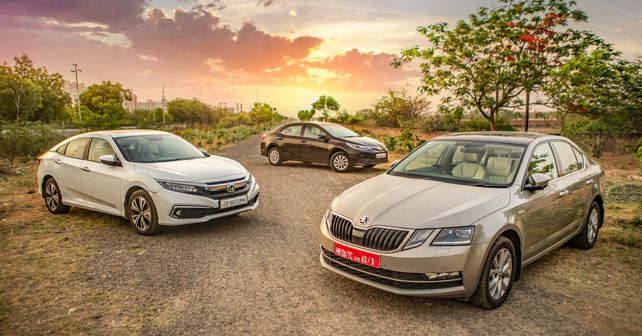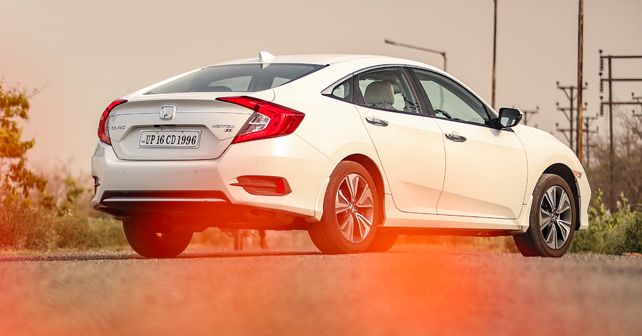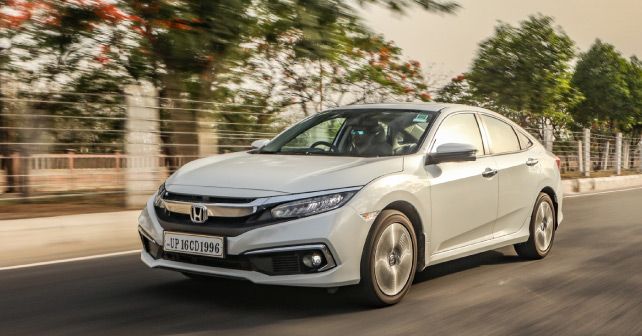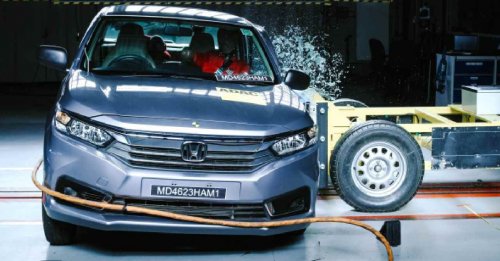The Civic re-enters the executive sedan segment after almost six years. Can it reclaim its crown and be the catalyst for the revival of this dying breed?
I know what you’re thinking – ‘if I had a buck every time I heard auto journalists write off the executive sedan segment, I’d buy the erstwhile Force India Formula 1 team.’ Before you accuse me of scepticism, and of being unnecessarily pessimistic, let me reveal to you the April sales figures in India of these D-segment sedans to put things into perspective. The Skoda Octavia managed to sell just 227 units, while the world’s most successful sedan – the Toyota Corolla – could only register 177 units.
The new 10th generation Honda Civic started its innings in March with over 2,000 units, but the following month it came crashing down to only 369 units. You might also be wondering why we haven’t mentioned the Hyundai Elantra? As capable as this sedan is, it’s dwindling figures are down to double digits.
So, was the Civic’s second month a cruel April Fool’s joke or does it have enough spunk to not only dethrone the Skoda but also become a beacon of light to rejuvenate this floundering segment?
Razor sleek Ninja
As successful as the Civic was in India, one wouldn’t be wrong to question Honda’s decision to relaunch this sedan at a time when the segment seems to have hit a dead end – due to the exponential rise in the popularity of SUVs. That notwithstanding, let’s take a look at this striking new sedan from Honda.
From all angles, and in any colour, this low-slung car looks absolutely stunning and has the ability to attract a lot of attention and make you feel like a celebrity. A lot has to do with its sloping roof, slender LED headlamps and Honda’s (now) typical solid chrome strip on the nose – and, of course, the unorthodox positioning of the indicators on the front wheel arches. They look smart and attractive alright, but there’s a pretty good chance of scraping and damaging them in the erratic traffic that we face every day.
In my opinion, the Civic looks the best from the rear, with the colossal C-shaped LED tail lamps. To add more character, the ‘Big H’ has decided to give it a set of nicely proportioned 17-inch alloy wheels – the biggest in the segment (both its rivals sport 16 inchers). It’s also equipped with LED foglamps, which is a first in the segment.
The Civic carries over its sporty, and youthful, design into the cabin as well. If I were to use one word to describe the cabin, it would be ‘futuristic.’ The busy multi-layered dashboard is made of leather and soft-touch materials and features an aluminium strip as well. But it all looks quite good together.
The fit-and-finish of the cabin is decent, but the hard plastics and the switches feel below par – especially for a D-segment car. It also boasts of a 7-inch all-digital split display behind the steering wheel, which lets you scroll through your phonebook and choose your favourite tracks from your playlist. As fancy as the 7-inch touchscreen floating infotainment display looks, it’s not as intuitive as we would have liked – and there is some lag. The other issue is that the positioning of the USB port behind the infotainment system makes plugging in your device slightly cumbersome.
When it comes to cabin practicality, the Civic scores very high. Since it comes with an electronic parking brake, the centre console is freed up to offer plenty of cubby-holes instead. Furthermore, 1-litre bottles can be stored in all four door compartments.
In terms of seating, you sit a bit low, which gives it a very sporty feeling. The seats are comfortable, and the rear bench offers plenty of under-thigh support, which is quite rare in this segment. Headroom, on the other hand, for rear passengers is rather limited – the sloping roof eats into space, which can cause a problem for tall passengers. Also, with relatively smaller rear windows – because of its coupe-like roofline – it doesn’t feel as airy as the other two cars.
As mentioned earlier, the Civic is a low-slung vehicle, and this may be a cause for worry regarding the car’s ground clearance – the previous version did suffer from underbody scraping. Fortunately, we came across no such problems, for the new Civic boasts 171mm of ground clearance.
The Civic comes loaded with 6 airbags and segment-first features like the remote engine start, which allows you start the engine to ensure that the cabin is cool before you enter the car. The latter, however, is available only in the petrol variant. The Civic also comes with a segment-first lane watch camera neatly tucked into the casing of the left outside rear view mirror, which lets you know if there are any cars trying to overtake you from the left.
The question, though, is this – is the Civic really as sporty as it looks? It may sound like I’m talking in riddles, but the answer is yes and no. For the first time in India, the Civic gets a diesel engine, as it borrows the 1.6 i-DTEC motor from the CR-V. With 118bhp under the hood, it offers linear pickup and has decent poke from as low as 1,400rpm.
What’s slightly disappointing, though, is that the engine lacks urgency, especially in the mid-range – but it’s still plenty for your daily commute. It’s quite evident that Honda’s focus here is on fuel efficiency, and this results in the Civic offering class-leading mileage.
Sadly, the diesel variant doesn’t come with an automatic transmission. They could have easily used the CR-V’s 9-speed torque converter, which actually offers a more involving driving experience thanks to its shorter gear ratios.
What makes the Civic stand out, though, is how well the steering wheel weighs up at higher speeds. The steering feels direct, and the car darts around turns and corners confidently, even when you push the pedal to the metal. And, in terms of handling, the Civic really excels. In fact, its dynamics are among the best in the segment, and body control is very good too.
Even though the Civic comes with 17-inch alloy wheels, and offers a firmer ride than its competition, in no way is it compromised. The suspension setup and raised ride height allow the Civic to easily dismiss large speed breakers and pot holes with great poise.
Swashbuckling stormtrooper
The Octavia received a mild facelift two years ago. And what really stands out since – whether good, bad or indifferent – are the quad headlamps, with the LED lights smartly tucked inside them. The butterfly front grille is now all-black, and the bonnet is now a lot more pronounced. The lower lip of the front bumper sports a thin chrome line running across it, like the Superb, and the rear LED lamps have been redesigned ever so subtly. The Octavia continues to retain the typical Volkswagen family DNA – it remains muscular and yet sports a simple design.
The Octavia’s cabin is solidly built, whether it’s the quality of the materials or the fit-and-finish. Unlike the busy cabin design of the Civic, the Octavia has a very clean and user-friendly design. The infotainment system has an 8-inch touchscreen, which is not only bigger than that of the Civic’s but also more responsive and intuitive. The graphics on the screen are a lot crisper too.
Both the Civic and the Octavia come with Android Auto and Apple CarPlay, but the latter also offers MirrorLink. Plus, the USB port is on the central console below the climate control, making it a lot more accessible. The all-digital instrument console is a lot easier to read, and also feels more premium.
With a dual-tone cabin and bigger windows, the Skoda feels very spacious. Though, in terms of practicality, the Civic offers more cubby-holes and storage spaces. The Octavia comes with 8 airbags and both front and rear parking sensors, in addition to a parking camera. And, of course, like the Civic, it comes with rear AC vents.
Another highlight of the cabin is the way it cancels out all kinds of outside (and drivetrain) noises. The Civic’s cabin also manages to shut out unwanted sound, but, every once in a while, road noise does manage to creep in.
Now, in terms of passenger comfort, the Octavia offers the best legroom for rear passengers, despite having a shorter wheelbase than the Corolla and the Civic. The rear seats are higher in the Octavia, making it easier to get in and out of the cabin. The seats are comfortable, though slightly firm, but when it comes to seat squab support, the Civic leads the pack.
With 141bhp under the hood, the Octavia is easily the most powerful sedan here. So, from the word go, it takes off unapologetically. The DSG transmission is a mind reader – it knows exactly when to upshift or downshift, negating any turbo lag. The Octavia also comes with paddle shifters, which makes the driving experience more involving. That’s not to say that you’re forced to use them, however, as the DSG is brilliant all on its own.
Courtesy of its multi-link rear suspension setup – similar to the Civic – the Octavia offers a very relaxed ride, especially for the rear seat passengers. It simply sails over potholes. And, being a Volkswagen product, it doesn’t go wrong in terms of handling either. The Octavia feels as stable as a rock at high speeds. What it does lack is an involving steering. As is, it’s quite light and feels fairly lifeless.
Sure, it’s great to drive in the city and is easy to park in a crowded space, but it falls short when compared with the more wholesome Civic.
Ever-reliable Samurai
In all fairness, the Toyota Corolla Altis is in the last phase of its current lifecycle – and it’s starting to show its age. Sure, Toyota has tried to spruce it up with an all-chrome V-shaped front grille and those swept back LED headlamps. But, sadly, it looks quite dated – especially in front of the Civic.
The Altis is the senior statesman in this shootout. But what stands out like a sore thumb – and something that we can’t explain – is the fact that a `19.36 lakh (ex-showroom) sedan doesn’t come with an infotainment system. I promise you I’m not kidding. You get steering wheel controls, but, for a system, you have to shell out extra cash. Thankfully, this bad joke is limited to the diesel variants only. The petrol version does get one, but it is fairly basic – no Android Auto or Apple CarPlay to be found here.
The plastic quality is not the best in the segment either, but it’s functional. The spartan cabin can be slightly disappointing, but with big windows, it feels airy. Fortunately, there’s no compromise in terms of safety – as it comes with 7 airbags.
Space and comfort for rear passengers remain the Corolla’s highlight. As most car owners in this segment prefer to be driven around, the Corolla continues to be a popular choice. The seats are wide, comfortable and three passengers can fit easily. This is possible because of the virtually flat floor. Plus, the Corolla is the only sedan that has a reclining option for the rear seats. But, sadly, it doesn’t come with rear AC vents – which really are a must-have in this day and age.
With only 87bhp on offer, it may come across as being underpowered on paper, but once you step on the accelerator, you realise how linear and refined this engine really is. Sure, it doesn’t have the urgency of the Skoda, but with buttery smooth acceleration, you can’t fault it for not having enough power. But comfort remains the key for the Corolla, along with the fuel efficiency.
And, the winner is…
Let’s start with the radical looking Civic. It looks awesome, has the best seats (even though they are quite low), is the cornering king, and has the makings of being the most involving and fun car in the segment. Unfortunately, the diesel Civic doesn’t come with an automatic gearbox and has an engine that’s tuned more for fuel efficiency – which does become a bit of a buzz-kill.
The Corolla Altis has been ruling the roost for ages now, and the next-generation sedan should make it an even playing field for Toyota. Technically, there’s nothing wrong with the Altis. The engine is great for commuting, the cabin is spacious, and the rear can pack in three adults. It also offers a generous boot, with 470 litres. And, of course, there’s always Toyota’s legendary reliability. You buy it, fill it up and then drive it to the end of the world without a worry – and it’ll make sure you return home too. However, it’s ageing – badly!
The crown, then, resides firmly with the Octavia. It comes with all the features, and it feels premium – which is why it’s the most expensive sedan in its class. When it comes to power and sophistication of the drivetrain, nothing comes even close. Plus, Skoda has also launched the Skoda Shield Plus that includes an extended warranty (up to 6 years or 1.5 lakh kms), car insurance and roadside assistance. So, this should give you a peace of mind before you sign on the dotted line.
More than anything else, though, what we learned in this test was that these sedans offer a driving experience – the Octavia and Civic certainly – that’s superior to any SUV in terms of driving pleasure. And they’re very comfortable too, especially for rear passengers. So, before you put your money down for that high-riding SUV, check out these sedans once again. You’ll enjoy the drive – we can promise you that!
The Civic comes with an electronic parking brake, a first in the segment – which frees up the centre console to offer plenty of cubby-holes.
Comfort remains the key for the Corolla. The rear seat is wide and comfortable enough to accomodate three adults. Plus, the Corolla is the only sedan that provides a reclining option for the rear seats.
- Honda Civic ZX MT i-DTEC
- Skoda Octavia L&K 2.0 TDI
- Toyota Corolla Altis D-4 DGL
Engine: 1,597cc / 4-Cylinders / 16 Valves / DOHC / Turbocharged
Fuel: Diesel
Transmission: 6-Speed Manual / Front-Wheel Drive
Power: 118bhp @ 4,000rpm
Torque: 300Nm @ 2,000rpm
Price: ₹22.31 lakh (Ex-showroom, Delhi)
X-factor: The Civic offers a sexy coupe-like design & a driver-centric cabin.
| Pros • Handling • Features | Cons • The engine could have been punchier |
Engine: 1,968cc / 4-Cylinders / 16 Valves / DOHC / Turbocharged
Fuel: Diesel
Transmission: 6-Speed Automatic / Front-Wheel Drive
Power: 141bhp @ 3,500-4,000rpm
Torque: 320Nm @ 1,750-3,000rpm
Price: ₹25.99 lakh (Ex-showroom, Delhi)
X-factor: A treat for those who love to be behind the wheel.
| Pros • Rear seat space • Power packed engine | Cons • Expensive |
Engine: 1,364cc / 4-Cylinders / 8 Valves / SOHC / Turbocharged
Fuel: Diesel
Power: 87bhp @ 3,800rpm
Torque: 205Nm @ 1,800-2,800rpm
Transmission: 6-Speed Manual / Front-Wheel Drive
Price: ₹19.36 lakh (Ex-showroom, Delhi)
X-factor: Best suited for rear seat passengers.
| Pros • Spacious cabin • Toyota reliability | Cons • No infotainment system • Age |

Also read - MG Hector Review



































Write your Comment